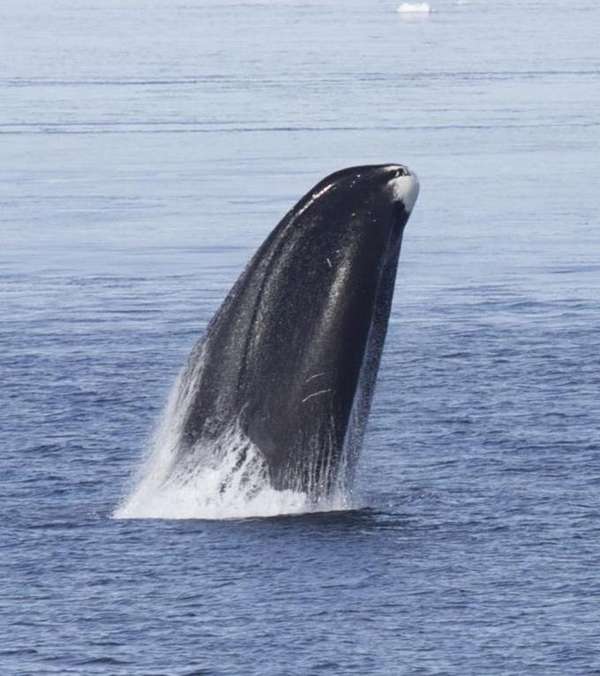Genome Sequencing of 200-Year-Old Whales May Help Humans Fight Disease
 For the first time, the genome of a mammal longer-lived than man has been sequenced: the bowhead whale, who lives 200-plus years, and gets far less cancer given its size.
For the first time, the genome of a mammal longer-lived than man has been sequenced: the bowhead whale, who lives 200-plus years, and gets far less cancer given its size.
Researchers from the University of Liverpool reported the result of the sequencing in Cell Press: the unearthing of genes that may be associated with longevity and cancer immunity. The researchers want to create longer-lived mice by giving them some whale genes—which they hope will lead to potent new (human) drugs.
“I was excited during the course of this project that we discovered changes in bowhead genes related to cell cycle, DNA repair, cancer, and aging that suggest alterations that may be biologically-relevant,” senior author João Pedro de Magalhães told Bioscience Technology. “My own view is that this points toward improved DNA repair, and cell-cycle regulation mechanisms, to prevent DNA-damage accumulation during the life-course, which in turn promotes longevity and resistance to age-related diseases, like cancer.”
“I find the idea of comparing genome sequences between species, to work out the mechanism of evolution, extremely exciting,” UK National Health Service pathologist Jim Morris told Bioscience Technology. Morris, uninvolved in the study, has written about cell cycles and aging. “This is first-class science.”
Some surprises
De Magalhaes, head of the University of Liverpool’s Integrative Genomics of Ageing Group, said his research did not unearth many of the usual suspects.
“I was surprised that we didn't find genes in common with those found in other long-lived species, like bats and the naked mole rat,” he said.
Noting that his group has also conducted a genome analysis of the long-lived, cancer-resistant naked mole rat, de Magalhaes added, “Some pathways may be shared in common by long-lived species, like DNA-damage responses, but the specific genes involved seem to be different. My view is that different species can possess different ‘tricks’ to acquire a long lifespan. By discovering the ‘tricks’ used by the bowhead—the only species sequenced thus far that outlives humans—we may, in the long-term, be able to apply those findings to humans in order to fight age-related diseases.”
His biggest challenge, de Magalhaes said, “was the computational work, which—even on pretty powerful computers—took a long time. Generating the sequence data is easy. The hard part is the bioinformatics.”
De Magalhaes said mouse models incorporating some of the whale genes “would be ideal to determine if these genes emerging from the bowhead genome can protect against age-related diseases or even promote longevity. As you imagine, these are expensive studies, and at the moment we do not have the funds to perform this line of work, so we haven't decided which genes to focus on yet.”
But, he said, “ERCC1 and PCNA I would say are the most exciting so far.”
ERCC1 is involved in DNA repair, so it may be involved in cancer protection. Sections of PCNA—which is involved in DNA repair and cell growth—are duplicated in the bowhead. This may help prompt longevity.
Positive response
The response “has been very positive thus far, both in the media and by colleagues,” de Magalhaes said. “I have heard of several researchers wishing to employ these data, not only to study longevity, but also to study other aspects of whale biology. This is very gratifying, since my main aim in this project is not so much what our lab can find, but primarily to encourage others to study these extraordinarily long-lived animals.”
Bowheads, whose age was pinpointed with the aid of old arrows found in their flesh, is an endangered species. The whales possess 1,000 times more cells than humans, but acquire far fewer cancers.
This could be due, de Magalhaes told Bioscience Technology to “differences in stem cell divisions. Or the level of damage that accumulates with each division could be important in this long-lived species.”
He would like to study stem cells in the bowhead, but he doesn’t believe this will be possible “due to very limited sample availability. It is extremely difficult to obtain samples from these animals, and we were lucky enough to obtain DNA and RNA.”
While Morris, on the other hand, applauded the sequencing effort, he is “somewhat doubtful of its relevance to cancer. The idea that genes from long-lived whales can be inserted into our stem cells to protect us from cancer, which has appeared in the popular press, is fanciful.”
But, as the report noted, “studying species such as bowhead whales that have greater natural longevity and resistance to age-related diseases than humans may lead to insights on the fundamental mechanisms of aging.”
The National Oceanic and Atmospheric Administration said that “bioprospecting” in the oceans has yielded many drugs. Examples include a Caribbean sponge that generates compounds used in the anti-AIDS drug AZT (Retrovir); the Caribbean gorgonian (a soft coral), which generates anti-inflammatory compounds appearing in an anti-wrinkle cream; the bryozoan Bugula neritina, which generates a compound being tested as an cancer therapy; skates, which have offered insights into blindness; corals and mollusks, used in orthopedic implants; horseshow crabs, used to test for bacteria; and microalgae, offered in nutritional supplements.
Coral skeletons are being studied as potential bone grafts. Sea snail venom is being analyzed as a pain reliever. Shark skins are being studied for infection-fighting qualities.
Not just old—but ancient
Other studies in recent years have found bowheads may reach such an advanced age in modern times because they are long-lived in evolutionary terms as well.
In 2013, a DNA analysis published in Nature indicated that bowhead whale lineages survived Late Pleistocene climate change.

